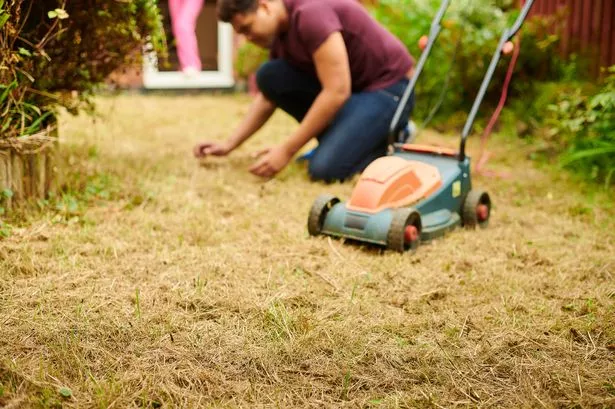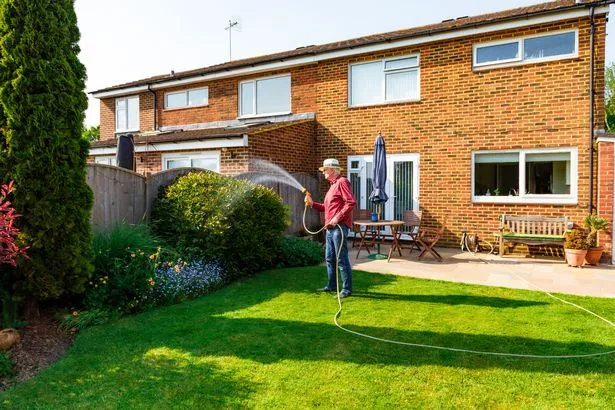The warm weather can be detrimental to our gardens, but following this expert advice will help prevent it A heatwave could dry your garden out(Image: Getty Images)
A heatwave could dry your garden out(Image: Getty Images)
With summer on its way, there is no better way to mark the start of the season than a heatwave which is expected this weekend. But whilst we may welcome the warmer weather, it’s not always a good thing for our lawns.
But according to experts from MyBuilder.com, there are several ways to protect our grass from the summer heat – including one simple task which takes minutes to do.
The worst thing for lawns over summer is the damage done by placing items on top of the grass – particularly paddling or swimming pools.
Plants require sunshine and oxygen to survive and thrive, so keeping your pool on your grass is damaging for it.
After one day of a pool being left on grass, it will show signs of turning yellow because there is no water, air, or sunlight.
By days two to three, the lack of these factors will trigger a dormant state of grass.
Finally, after a pool is left for about two weeks on the same patch of grass, the grass will be dead.
Therefore, it is advised to move garden furniture and paddling pools around your garden now and regularly during the heatwave to avoid this issue.
 Experts are issuing advice on how to keep your garden in the best shape during the heatwave(Image: Getty Images)
Experts are issuing advice on how to keep your garden in the best shape during the heatwave(Image: Getty Images)
Expert gardener James Lewis, of MyBuilder.com, said that there are many myths around how to protect lawns from heat damage – and many aren’t accurate.
“So many people are certain that laying down any sort of mat or rug under paddling pools or other common garden objects will save your grass – but that’s totally untrue,” he said.
“Mats, tiles, foam squares, sand – none of these things will change the fact that placing an object onto grass will stop the plant accessing the very elements it needs to survive – oxygen, and sunlight.
“The good news is that grass is extremely resilient, and with certain steps you can protect it or repair it after damage, and normally it recovers extremely well.”
Other garden heatwave tips from the MyBuilder.com expert include:
Rake it up
If your lawn is looking a bit shabby, a simple solution is to give it a good rake.
This applies whether it’s been covered by an object or even if it’s just looking a bit droopy. Rake it up to a standing position again, and let the grass do the rest.
If the weather cools, it should take less than a week for it to be looking sprightly and green again.
Aerate your lawn
In hot weather, your soil can actually start to repel water, meaning you won’t be able to properly hydrate it. Aerating the ground creates channels in the soil, allowing air, water, and nutrients to reach the grass roots more effectively.
To aerate your lawn, you can use a specialist tool for that purpose, or you can even just use a garden fork to spike the lawn and provide holes for water.
 You should water your garden regularly during the heatwave – but not too much(Image: Getty Images)Keep on watering
You should water your garden regularly during the heatwave – but not too much(Image: Getty Images)Keep on watering
Watering your lawn is essential in hot weather, but make sure you do it at the right time, and not too often.
Watering in heat can scorch your grass, so choose early morning or late evening for a deep hydration session.
Should you have patches of grass that have gone brown, continue to water it even if you think it might be dead as it can still re-emerge in a matter of a few days.
Mowing
To maintain your lawn in hot weather, it’s advisable to leave it a bit longer than usual and remove your grass collector to allow the cut grass to feed nutrients back into the soil.
Longer grass will provide shade for the soil from the scorching sun and protect the blade further down.
However, if your grass is already severely damaged, mow it shorter. Weeds flourish in low light conditions, which would have been created by any sort of pool covering it.
By mowing the area to reduce the weeds, it will encourage grass to regrow. Additionally, spread grass cuttings on the area and it will enrich the soil with nutrients.
Grass seed
Grass seed thrives very well at this time of year, so if you do notice any damage that can’t be repaired, reseed it as soon as possible. Most grass species take about six to eight weeks to be fully grown without patches.
Add top dressing on top of the seed to prevent it being eaten by birds – and it also helps retain moisture and improve the soil for the future.

